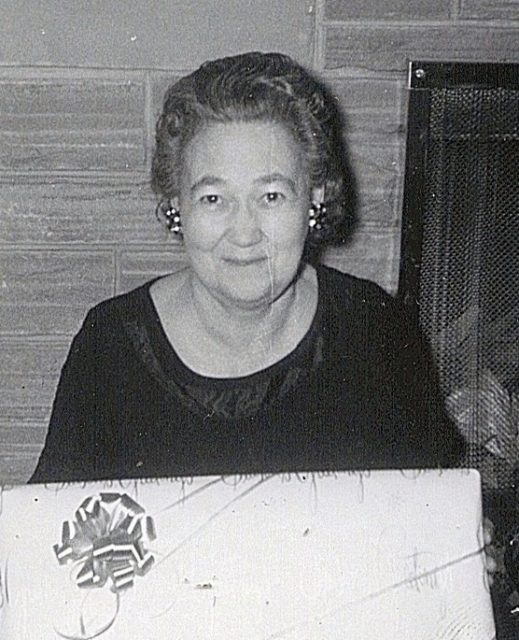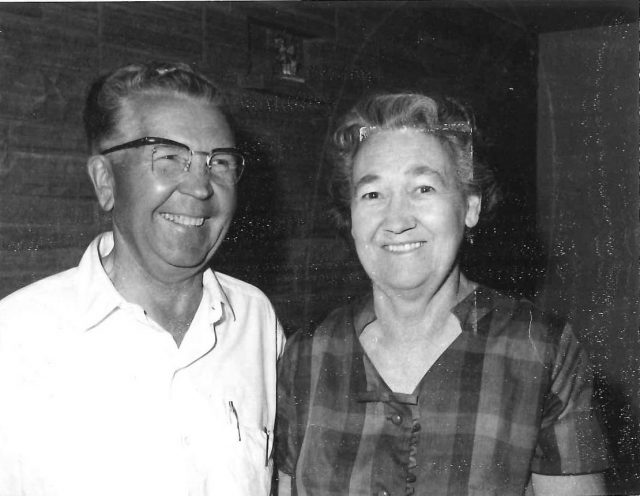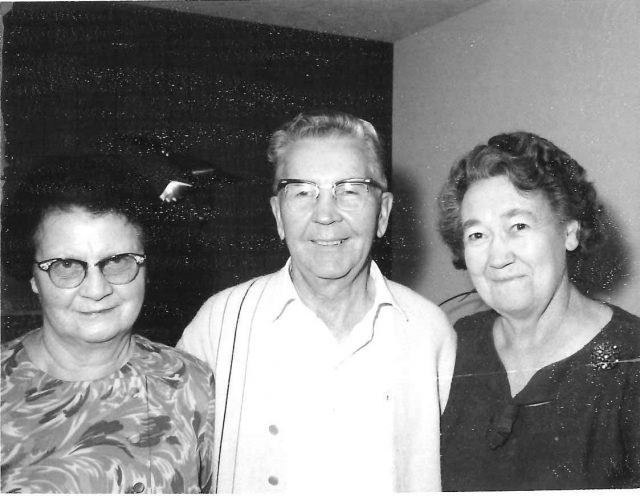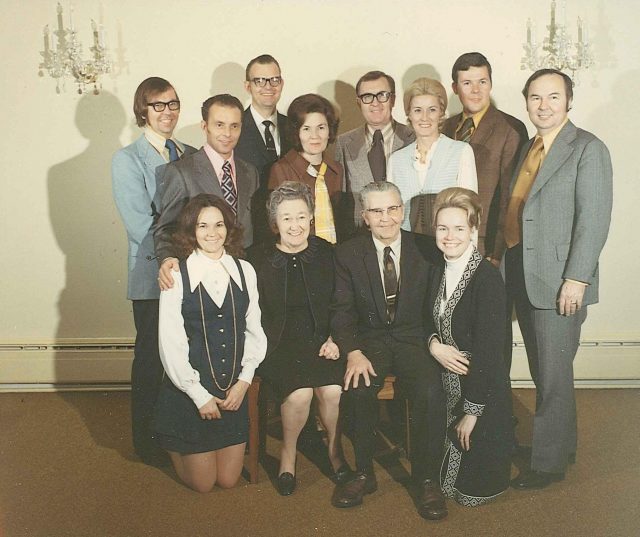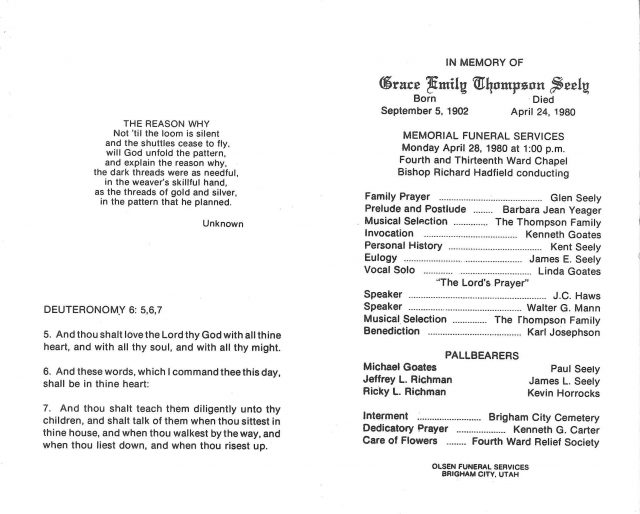Grace Emily Thompson Seely (1902-1980)
Grace Emily Thompson and Francis Leland Seely (“Jim”) had 7 children: Kathryn Joyce Seely (1928-1971, known as Joyce; who married Lynn Thomas Richman, Glen McLain Seely (who married Jean Jamison), John Leland Seely (1932-2006, known as Lee; who married Muriel Martel [1934-1992]), Gwendolyn Seely (known as Gwen; who married Kenneth Joseph Goates), Karen Seely (who married Daryl Galloway), James Edward Seely (known as Jimmy or Jim; who married Ellie), and Richard Kent Seely (known as Kent; who married Mary). See the page for these children.
Her parents are John Ernest Thompson (1869-1954) and Jane Bosomworth (1871-1944).
Records
- Family group sheet with photos
- History of Grace Thompson Seely, written by Grace and Kent Seely
- Life sketch of F. Leland and Grace Emily Seely by James E. Seely
- Life Story of Grace Emily Seely from the book John Ernest Thompson and His Family compiled and edited by Kenneth Joseph Goates, pages 334-344
- Summary History of Grace Thompson Seely, edited by Robert H. Thompson
- Index of Seely family names by Kent Seely
- Aunt Jen’s letter to Kent Seely
- Watch family videos including Grace Seely on the Richman Family YouTube Channel.
- Seely family white photo album
- Seely family red photo album. (Part 1 contains photos mostly of Glen, Joyce, and Lee. Part 2 contains photos of Gwen, Karen, Jim, and Kent.)
- Thompson family brown album. The album starts out with pictures of the Thompson family and finishes by adding the Seelys.
Life Summary
Grace’s parents are John Ernest Thompson and Jane Bosomworth. Her father belonged to the upper class. Two of his great aunts married Princes. Her grandfather entertained the King of England at his “Kursel” in Harrogate, a beautiful opera house where he had his own box in the center balcony. The king and his party would come to bathe in the sulfur springs that were in Harrogate. Her mother was a beautiful girl from the sturdy middle class.
Grace was born September 5, 1902 in the little village of Barrowby, England. She was a beautiful girl with a perfect oval face, beautiful dark brown eyes, and lots of long, golden curls. She was small and dainty. Her father, mother, older brother, and sister were baptized into the Church on Grace’s sixth birthday, September 5, 1908.

The Thompson family in front of their home in Borrowby, England, in 1909. Grace Thompson is the girl in the center in front.
On May 17, 1910, the family sailed from Liverpool on the steam ship Zeeland to come to Utah.

The Zeeland ship log for May 17, 1910, the day the Thompson family sailed from Liverpool for Boston. The names are The names are John E, Jane, J. Henry, Jennie, Gracie, and Edward. Their destination is listed as “Salt Lake.”

The Zeeland ship. The note says, “The ship we had passage on from Liverpool England to Boston, Massachusetts in May 1910. We arrived in Murry, Utah May 31, 1910. My father & mother, John Ernest Thompson and Jane Bosomworth with children John Henry, Jennie Louisa, Grace Emily, & Edward Alva.
In the fifth grade (December 1914), her parents moved to Idaho and homesteaded at Reed Springs on the Raft River, 5-8 miles from Almo. They lived in a one-room log cabin with a sod roof and a dirt floor, quite a change from the upper-class life they enjoyed in England. In England, her father had a personal valet to serve him. Here, he had to learn to live off the land covered in sagebrush. It was 16 degrees below zero that first winter.

This 1918 picture shows Grace (age 16) and her family at Reed Springs, with the Raft River in the background.
In 1918, Grace moved to Oakley, Idaho, to attend high school.
In January 1919, the Spanish Flu epidemic reached Southern Idaho and they closed the schools. A girlfriend from Almo was also going to school in Oakley and her brother came to get them with a team and a wagon. On the way back, they got caught in a terrible blizzard. The snow was so deep that the horses couldn’t pull the wagon through it, and mom and the other two had to get out and tramp a trail in the snow for the horses. When they got to the City of Rocks, they pulled off and took shelter behind one of the huge rock formations. The families in Almo knew that they were coming and that they would have been caught in the blizzard and so they had sent a rescue party to meet them. The rescue party finally found them and brought them back to Almo.
In 1920, she attended Brigham Young Junior College in Logan. Both in Oakley and in Logan, she lived with a family to clean and help with their children for her room and board. She worked in the summers to pay for her school. In her freshman year, returning home from Oakley, they were caught in a snow storm and nearly died.
Grace got her teaching certificate and taught school in Malta, Idaho. She always began the school classes with prayer. Her golden hair had now turned to a gorgeous auburn and her fifth and sixth grade students had crushes on her. She resisted and instead dated Irv Maddox (who later started the Maddox Ranchhouse in Perry), then sent him on a mission.
She then transferred to teach 20 students in a one-room school in Rosette. While traveling to spend Christmas with her brother in Malta in 1923, she got caught in a blizzard and her whole body had turned black from exposure to the cold. It lasted only a day or two, and then it was gone.
After teaching in Rosette for two years, Grace had a problem. She had two fine young men who had asked her to marry them. She spent the summer with her sister Jennie in Oregon, and there met Herb Lundy, who also asked her to marry him. In fact, Herb said that if Grace wouldn’t marry him, he wouldn’t marry anyone. But, he wasn’t a Latter-day Saint, and Grace was not about to give up her faith that her parents had sacrificed so painfully much for.
In the fall, Grace went back to Rosette and decided to marry the bishop’s son, Francis Leland (“Jim”) Seely, which she did in the Salt Lake Temple on June 23, 1926. (Jim sometimes called Grace “Pinky” because of her red hair.)
They lived in a little house on a ranch in the Park Valley area in western Box Elder County, miles from the nearest neighbors. Grace had gone through a series of miscarriages, and was again several months pregnant in 1927 (age 24) when Jim had to leave for several days to look for cattle. Just after he left, she began to miscarry. She was in great pain and bleeding profusely. After praying to the Lord for someone to help her, a man appeared, which she described as not of this world, and healed her. Shortly after the man left, a neighbor Sister Burton, arrived. Although the only road from the home ran passed the lady’s home, she didn’t see the man. Sister Burton came because she had a strong impression that Grace needed help.
The neighbor stayed with Grace until Jim returned home. Jim then took Grace to a doctor, who said that Grace must never try to have children or it would kill her. But Grace was determined to have a family, and with faith and prayer, and after several more miscarriages, she subsequently gave birth to seven children.
For most of her life, she taught Primary and Sunday School and was loved by the children and teenagers alike. She helped organize junior Sunday Schools in many wards in the stake and was also primary chorister. She sang with Norm Watkins Orpheus chorus. She sang with a double trio at the Logan Temple and sang many solos in church and on programs. See photo of the Brigham City 4th Ward chapel where the Seelys attended.
Grace taught the first LDS Sunday School at the Intermountain Indian School. Under the leadership of Boyd K. Packer, she also taught enlarged classes for the LDS Indians at the Brigham City chapel. These classes included boys and girls of all ages. She not only taught them in religious doctrine, but she also tried to help them to live better and understand the ways of the white people with whom they had to integrate in daily life. Many Sundays found many Indians fed and entertained in her home. As they learned from her, she learned from them.
In 1962-63, Grace won the local “Mother of the Year” contest during Brigham City’s Peach Days and was the city’s entry for the state contest.
Grace’s faith helped her and her family throughout the years. Grace and Jim hosted numerous gospel study groups in their home. They were director members of the Box Elder Knife and Fork Club.
Read more about Grace’s and Jim’s life together on the page for Francis Leland “Jim” Seely.
Grace Emily Thompson Seely died April 24, 1980, and was buried April 28 in the Brigham City Cemetery. She and Jim were married 54 years.
Photos

Jim and Grace Seely

Frances Leland and Grace Seely

Seely clan, March 1968, Left to right: Joyce, Gwen, Glen, Leland (Jim), Kent, Grace, Jimmy, Karen, Lee
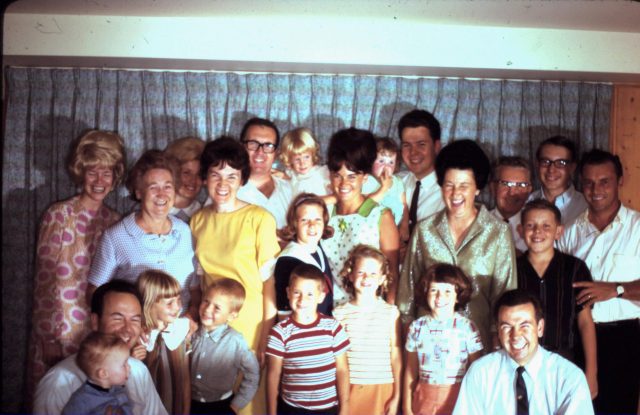
Seely & Richman families. Left to right (back row): Muriel, Grace, Jean, Gwen, Glen, Kristen, Jan, Karen, Kathy, Kent, Joyce, Leland, Larry, Jeff, Lynn; (front row); Richy, Lee, Linda, Mike, Rick, Laura May, Joy, Jim

Seely and Richman families in Brigham City (outside the Seely home). Left to right (back row): Grace, Larry, Glen, Leland, Joyce, Ken, Gwen, Karen, Brandy, Jim; (front row): Joy, Linda, Mike, Rick, Kathy

Grace Thompson Seely, Boston Thomas Richman, and Francis Leland Seely in December 1966

Boston, Grace, Joyce, Leland (“Jim”)

Lynn, Joyce, Leland, Joy, Grace at the Salt Lake house

Grace, Leland, Verna, Ken

Grace behind the Brigham home












